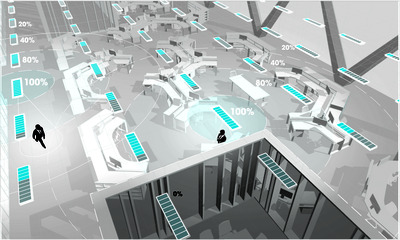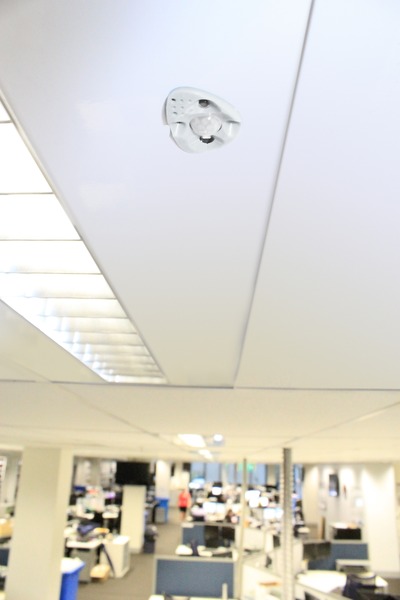Distributed intelligence - the new paradigm in lighting control
Smart lighting control systems make a significant contribution to the effective operation of commercial buildings. As the race towards new technologies for lighting control continues, the prospect of creating smarter, more intuitive controls is seemingly straightforward - all a system really needs to do is to make decisions about which lights to switch on, and how brightly, based on information in the space beneath them.
The reality, however, is that the bulk of advanced commercial lighting control systems, despite being built to be flexible, are overly complex. In large part, this stems from the fact that these are addressable systems that require centralised network control and the capacity to identify and communicate with each system component in order to function. Their complexity is compounded by the need for extensive maps of sensors, light fittings and associated equipment, and undermines the basic purpose of a truly effective lighting system: to switch on each individual light to a required level, at the required time, and to switch them off when not in use.
However, innovations in the lighting control space are giving rise to a new generation of distributed intelligence systems that are based on the patterns of nature. Distributed intelligence is the separation of system components from a central control/command module. In a school of fish, for example, there is no master fish collecting information and sending out commands; instead, each fish simply observes its environment and neighbouring fish in order to make independent decisions.
This is distributed intelligence in action.
In an engineering context, distributed intelligence refers to the ability of individual system components to make their own decisions based on information available in the immediate vicinity. Crucially, these components need no knowledge of their neighbours’ identities, nor a map of the layout; systems based on distributed intelligence have the capacity to overcome issues associated with centralised control by removing complexity, rather than adding it.
Melbourne-based business Organic Response has developed a fully distributed intelligence-based lighting control system. Each component of the Organic Response system can stand alone, both mechanically and electrically. Components make all decisions at a local level but operate en masse as a cohesive system.
The system works on the basis of every light fixture having an integrated sensor node. The sensor node comprises a motion sensor, an ambient light sensor, an infrared transmitter and an infrared receiver that enables proximity limited wireless communication between the fixtures.


In an office environment, for example, the presence of a person underneath a light fitting will trigger that light to come on, and it will simultaneously transmit a Level 1 message to its direct neighbours, alerting them to the fact that there is activity taking place within one light fitting of their location. These Level 1 fixtures then switch on at a predetermined lower lux level that corresponds to their distance from the activity and transmit a Level 2 message that instructs their immediate neighbours to activate in a similar pattern. The message propagates rapidly throughout the office, informing every sensor node of its proximity to the source of motion.

The infrared messages being transmitted from node to node contain real-time, location-specific occupancy information; collectively, this information is known as the Occupancy Information Cloud (OIC). The OIC delivers crucial occupancy data throughout the system, allowing each node to combine the information with its local ambient light data to make logical, individual decisions.

A recent Arup report into an Organic Response installation in the Commonwealth Bank head office in Sydney revealed that the model achieved substantial energy savings over and above those captured by the site’s existing timer-based DSI system. The Organic Response system also met occupant comfort requirements head on and was identified as one of the first systems on the market to meet the notorious challenge of effective task lighting:
“The system presents a number of key features that conventional addressable systems don’t, and this achieves high energy savings, high levels of occupancy comfort and [helps achieve] many Green Star credits.”
But the benefits of Organic Response, and of distributed intelligence-based lighting technologies as a whole, are broader still. Truly distributed systems are completely plug and play, infinitely scalable and have inherent redundancy. Because all the control technology is located in the light fitting, there is no external infrastructure to be installed and programmed. The sensor nodes have no unique identity or address, which means the system will continue to function if one or more light fittings are removed. Adding light fittings is equally simple; a new fitting will simply start listening, responding and contributing occupancy information as soon as it is connected to the system.
These systems also deliver higher levels of occupant comfort, in which lighting control systems play a significant role. Timer-based control systems are designed to switch off lights irrespective of whether there are still occupants in the room, while addressable systems simply can’t sustain the density of sensors required to reliably ensure occupant detection, or deliver dynamic zoning the way that a distributed intelligence system can.
So, if distributed intelligence is such a revolutionary approach to lighting control, why has the industry been so focused on addressable systems? To being with, high-tech lighting control is a relatively recent phenomenon. Initially, the path of least resistance for developing new systems was to build them on the network architecture of more mature systems, such as BMS, that depend on the addressable paradigm to function.
Cost is another issue - up until recently, the cost of inserting sensors into every fixture of a lighting control system was prohibitive. However, in the last few years, the cost of electronics such as processors and sensors have dropped significantly, allowing electronics developers and manufacturers to take huge steps forward in developing new technologies.
The true power of the distributed intelligence system, however, lies in the OIC. The sensor nodes of the Organic Response system use this information to control their lighting levels, but more strategic use of the OIC might be just what the industry has been looking for in its quest for full integration of building systems, such as HVAC, security and computing systems.
To date, the coarse nature of occupancy data captured by addressable systems, and the complexity associated with transposing one map to another, is the ongoing argument behind why such integration is not being implemented. But a hybrid system - one that integrates distributed intelligence with existing building systems - would ostensibly provide all building systems with easy access to occupancy information: tapping into the occupancy data using an infrared receiver would provide the BMS with access to rich occupancy information for a whole floor via a single point on its network.
A hybrid system also has exciting implications for the simple execution of load shedding, or demand control. Electrical grids and building substations are getting more and more overloaded; in countries like India and Japan, peak electrical load is as much of an issue as the overall energy consumption. A hybrid system could easily reduce the peak electrical load of the lighting system by sending out a simple command that is relayed throughout the OIC to each fitting, telling it to go into a low load state when the electrical grid is stressed. A single sensor node connected to a BMS could receive the command from a central point and relay that throughout an entire floor of lights.

“The holy grail of energy management in the built environment is integration of building systems,” says Danny Bishop, co-founder and Technical Director at Organic Response.
“Given the diversity of the systems that are used in buildings, one of the simplest paths to improving their collective efficiency is for each system to have real-time access to common, location-specific, occupancy information. That is our vision for Organic Response as a distributed intelligence architecture.”
Such opportunities are just the tip of the iceberg when it comes to distributed intelligence and the opportunities it presents in both lighting and the broader building services industry. Organic Response has built the platform and the gates are now open for a raft of new innovations that take advantage of the exciting opportunities the technology presents.
Tackling EV misinformation at Everything Electric
Lauren Davis discusses all things EV with Robert Llewellyn, Red Dwarf cast member...
Let's talk about electrification, digitalisation and decarbonisation
Can the building sector use AI tools as a binding force for different energy efficiency processes?
A connected world: how smart systems are enhancing sustainability
The drive for smarter, smoother, more efficient connected and integrated infrastructure is often...




